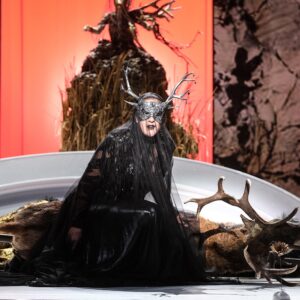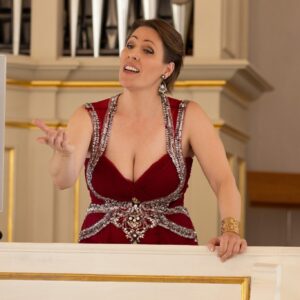I generally tend to avoid quoting overused bons mots, but in the case of Bayreuth Baroque I really cannot think of anything other than Hitchcock’s famous recipe for a good film. Max Emanuel Cenčić’s festival began four years ago with a veritable earthquake and tension has been steadily rising ever since. Cenčić is both the artistic director of the festival, and the director and performer of one of the leading roles in the stagings of forgotten Baroque operas prepared year after year, which on the surface seems like a perfect recipe for disaster. Yet the opposite is, in fact, true: Cenčić’s ambitious and visionary concepts are proving to be not only the highlights of the festival programme, but also the starting point for subsequent festival ventures featuring the stars of past performances, as well as an arena for new experiments in historically informed performance.
I dread to think what will happen next. After last year’s premiere of Handel’s Flavio I expected a temporary loss of form. I told myself that it was not possible to treat the audience every season to a production that would be so musically excellent and theatrically thoughtful. Especially given that all of Cenčić’s productions to date – in addition to their many other assets – have been marked by a light, almost burlesque sense of humour, which I hastily concluded was the most important feature of his directing. This year Cenčić reminded us of Ifigenia in Aulide, one of Nicola Porpora’s least known operas – despite its conventional lieto fine, a deadly serious thing, exposing humanity’s deepest moral dilemmas, explored at length by authors from Euripides, Racine, Schiller and Hauptmann, to Yorgos Lanthimos with his harrowing film The Killing of a Sacred Deer.
Ifigenia in Aulide. Photo: Clemens Manser
Ifigenia comes from the middle period of the composer’s career, when a group of aristocrats hostile to Handel, led by Frederick Louis, Prince of Wales, invited Porpora to London to throw down the gauntlet to the revived Royal Academy of Music. The Opera of the Nobility was inaugurated in December 1733 with the premiere of Porpora’s Arianna in Nasso at Lincoln’s Inn Fields Theatre, a month before the premiere of Handel’s Arianna in Creta, which was being prepared at the Haymarket theatre. After two not very successful seasons, the Opera of the Nobility moved to the King’s Theatre in Covent Garden and began regularly using underhand tactics against the rival company. The rivalry brought both sides to the brink of bankruptcy, but Handel won in the end. The Opera of the Nobility went out of business in 1737, having been ruined in large by demands of ever-higher salaries from the singers, including the contralto Francesca Bertolli, the castrati Senesino and Farinelli, and the bass Antonio Montagnana. Discouraged, Porpora left England, tried in vain to obtain a position at the imperial court in Vienna and eventually returned to Naples, where he rebuilt his reputation for a time with a new, revised version of Semiramide riconosciuta.
If you don’t count Festa d’Imeneo, his last London opera – or, in fact, a serenata – the 1735 Ifigenia received the frostiest reception from King’s Theatre regulars. Its run ended after only five performances, overshadowed by the much more popular Polifemo. The main culprit for the failure was probably Porpora’s regular collaborator, the librettist Paolo Antonio Rolli, who made the decision – misguided, as it turned out – to stick faithfully to the myth in Euripides’ version and focused too much on the relationships between the characters at the expense of effective dramaturgy. Yet musically, it is an extraordinary work, challenging the established stereotype of Porpora’s “old-fashioned” style. Despite its rather conventional structure – with plenty of virtuoso da capo arias alternating with secco recitatives – Ifigenia delights with its lyricism and beauty of melodic lines, variety of colour effects, as well as the composer’s method of constructing harmonic structures, already heralding classicism.
Aware that Rolli’s “Euripidean” libretto may, paradoxically, better appeal to the sensibilities of modern audiences, Max Emanuel Cenčić this time departed from the aesthetics of theatrical pastiche, creating a production that is clear, and, at the same time, marked by deep symbolism and a plethora of references to the myth’s “imagined” reality, which has changed over the centuries. I have already praised the set designer Giorgina Germanou’s talent for shaping space and mood with the help of simple, brilliantly lit decorations and expressive costumes (also by her this time) in connection with the pasticcio Sarrasine at this year’s Göttingen Handel Festival. The lighting director Romain de Lagarde bathed the sets in evocative shades of red, symbolising bloody sacrifice; idyllic blues; white, suggesting Iphigenia’s innocence; and the fathomless black of Diana/Artemis, in Greek mythology the goddess of hunting, but also of the moon and death. The nakedness of Agamemnon’s soldiers, bringing to my mind scenes from classical red-figure vases, and the war colours of the Myrmidons, Achilles’ cruel and uncouth companions, are contrasted with the ominous purple of the seer Calchas’ robes, the heroes’ costumes suspended outside time and the Baroque splendour of the Atreides’ clothing. However, what turned out to be Cenčić’s most interesting idea was the division of the role of Iphigenia between a young, silent actress (Marina Diakoumakou) and black-clad Diana sporting deer antlers on her head, who accompanies Iphigenia like a shadow – this highlighted the passivity of the eponymous heroine in the face of divine will and, at the same time, provided the tragedy with an expressive narrative frame: from the anger of Diana demanding a human sacrifice for the death of the deer, through her growing decision to save the unfortunate girl, to the inevitably emerging bond between the goddess and her future priestess on Taurida.
Ifigenia in Aulide. Jasmin Delfs (Iphigenia/Diana). Photo: Falk von Traubenberg.
The sophisticated staging made the extraordinary qualities of the musical interpretation all the more powerful. Who knows, this may have been the first time in my life that I witnessed a contemporary performance of a Baroque opera that verged on absolute perfection. I will not grumble that the role of Ulysses, intended for a female soprano, was entrusted to a man (Nicolò Balducci), while Farinelli’s successor in the role of Achilles was a singer with a voice less resonant than that of the famous castrato from Apulia (Maayan Licht). Both soloists demonstrated that a well-trained soprano countertenor can be a true heroic voice, comfortable across all registers, agile in coloraturas, secure intonation-wise in huge intervallic leaps, and fluent in the style of Neapolitan bel canto. In the role of Agamemnon Cenčić once again faced the legend of Senesino and once again emerged victorious from the ordeal, both as a technically sensational singer and a superb actor. A convincing character of Clytemnestra was created by Marie-Ellen Nesi, a singer with an unusually expressive dark mezzo-soprano. Riccardo Novaro’s resonant and supple baritone was flawless in the role of Calchas. However, the most impressive performance may have come from the young Jasmin Delfs in the dual role of Iphigenia and Diana – because of not only her beautiful, luminous soprano, but also her extraordinary ease and lightness of singing.
Aroma di Roma, a candlelight concert at Ordenskirche St. Georgen. Photo: Clemens Manser
All these wonders would not have happened without Christophe Rousset, leading the soloists and the orchestra of Les Talents Lyriques from the harpsichord with an uncommon sense of the idiom and the richness of the colours contained in the score, with an assured and decisive hand, usually at rather sharp tempi, but with such discipline that nothing was lost from the calibre of this music. The following day the French harpsichordist performed with a dozen or so of the ensemble musicians at a candlelight concert at Ordenskirche St. Georgen, accompanying the excellent Sandrine Piau in a programme comprising two secular cantatas on “Roman” themes, Montéclair’s La morte di Lucretia and Handel’s Agrippina condotta a morire, and Domenico Scarlatti’s cantata Tinte a note di sangue, a letter written in blood to an unfaithful lover, interspersed with instrumental pieces by Corelli and Alessandro Scarlatti. I was very moved by the evening: a display of the most tender collaboration between the musicians and the legendary singer, who more than made up for the now dull sound of her beautiful soprano with phenomenal technique and incredible maturity of interpretation.
Lucile Richardot. Photo: Clemens Manser
It is a pity that there was no such wisdom in Lucile Richardot’s concert the day before at the Schlosskirche with an attractive programme consisting of arias of the “Baroque sorceresses” – Medea, Armida and Circe – with the very capable Jean-Luc Ho at the harpsichord. Her extraordinary, almost tenor-like contralto is still deeply radiant. Her interpretations are getting increasingly mannered – to the detriment of both her voice and the music. It is possible, however, that I am too harsh on Richardot, still unable to recover from the delight of two evenings that transported me to a completely different dimension of historically informed performance.
This year I went to Bayreuth Baroque for a very brief visit – to experience an earthquake and a series of aftershocks. In future seasons I expect tsunamis, landslides and musical fires. Cenčić has already managed to surpass Hitchcock in the art of tension building.
Translated by: Anna Kijak




